Day 365 + ???? (who’s counting) of the pandemic and it seems like everyone is decluttering. We’re all trying to hold true to our reoccurring New Year’s Resolution to ”Get Organized.” Getting Organized can mean different things to us but it usually involves some sorting and culling of categories of stuff.
In our experience, there are always 3 decision buckets your stuff will fall into:
Our NAPO colleague, Barbara Hemphill, coined this brilliant definition: Clutter is Postponed Decisions.™ Clutter builds when we postpone decisions about:
• Do I really love it?
• Will I use it?
• Does it fill a void in my life?
• If I’m keeping it, where should it live?
While you do need to decide about your stuff, you do NOT want to stop the decluttering process to ponder each individual item.
Our time-saving advice is DEFER your decision for the “maybes” and “I don’t knows.”
These tricky decisions deserve attention — but NOT while you’re in the initial stages of rapid-fire, gut reactions to your stuff.
If you stop your intuitive process of deciding Yes, No, Maybe you won’t get through the whole category of stuff and you won’t see visible signs of progress. This will feel depressing and probably halt the whole decluttering process.
Follow our advice and schedule time with yourself — on a separate day — when your mind is fresh and you’ll taste sweet success. Technically, it’s called time chunking. In practice:
• One organizing session is dedicated to quick, visceral decisions.
• Another for contemplative, thoughtful and reasoned thinking.
Permission granted to defer your decisions on all of your “maybes” and “I don’t knows” — not because pushing off until tomorrow is a winning strategy. Permission granted because setting aside the necessary time to consider what deserves a place and space in your life is worthy of your full attention. In this case, deferring the decision is a smart move.
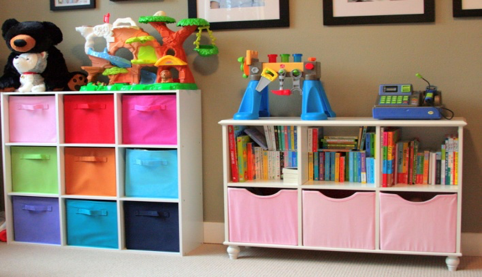
Written by Cathy Kay, Four Corners Organizing LLC
As a new-ish mom, and someone that works with clients that have kids, a HUGE hurdle to tackle is a child’s toy room. No matter how big your “toy room” is, it seems that the kids’ toys take over all rooms of the house. I don’t know about you, but I wasn’t really going for a Mickey Mouse aesthetic when we moved in.
Nonetheless, it has happened. So what’s the best advice for those who try to keep a clutter free home while also letting “kids be kids?” Let me count the ways!
1.) Label as much as you can.
A huge reason why it’s difficult for some kids to put away their toys is because they don’t know where things go. An easy way to keep games and toys that have a lot of pieces “contained” is purchasing a clear, multiple compartment drawer and labeling each compartment. This can be done with a label maker or even letting the kids help out and make their own labels! This is good for toys such as Legos, Kinex, Barbies, etc. This way, the kids know exactly where everything goes when it’s time to clean up.
2.) Big toys = Big problems.
I know a larger than life issue for me includes the “big toys”. Huge racecar tracks, kitchen sets, dollhouses, you name it. If you have an additional storage area available, such as a portion of your basement or spare bedroom, a toy rotation is your best bet. Put a few “big toys” out for a week, and then switch them out every other week. Once you start noticing your little ones have a favorite and keep going back to the same toy,
it may be time to add to the donation pile! This will keep those big toys from overflowing into every part of your home.
3.) Make cleaning up a game!
There’s nothing kids like more than a game, especially if they can win it! When there’s about 20 minutes left until bed time, or lunchtime (whenever the kids need to get their area cleaned up), set the timer. Tell them whoever gets their toys cleaned up first gets an extra story at bedtime, or their choice of dessert; something that they would really appreciate and enjoy.
Hopefully this will help those of you who dread looking at the toy room and can see see a light at the end of the tunnel. And hey, at least Christmas isn’t for another ten months!
Hopefully this will help those of you who dread looking at the toy room and can see see a light at the end of the tunnel. And hey, at least Christmas isn’t for another ten months!
By Karen Kabara, Yours Tasks – Our Time, Inc, (610) 847 5422

With the holidays here, is your head spinning with work deadlines, family obligations and holiday preparations (and let’s not forget quarantine fatigue)? There are plenty of suggestions online on how you can declutter your home but what can you do to declutter your mind?
Each thought floating around in your head is like a mental post-it note. The more post-it notes, the more mental clutter. Physical clutter can cause people stress, but mental clutter can as well. The easiest way to get the clutter out of your head is to jot down all those mental post-it notes so you can release it from your thoughts. Use whatever format is best for you to organize that information. You can use the Notes app on your phone to create a To Do List. You can add action items directly to your calendar, so you have time blocked on your schedule to complete them. You can use a productivity app, like Evernote, to capture all your notes and action items. Or, if paper is your preference, use a notebook. But keep your information to one notebook so there aren’t random pieces of paper all over the house that will get lost or create physical clutter.
Learning to Say No.
Capturing your mental post-it notes on paper or your device is helpful to organize your thoughts. But how do you reduce the amount of post-it notes creating that mental clutter in the first place? Learning to say no can help.
Many of us overschedule ourselves. Accepting every party invitation. Volunteering to organize every event. But when you’re constantly exhausted and stressed out, it’s probably time to make some adjustments and dial back the schedule.
Saying no can be difficult. Saying no can be filled with guilt. But it can also be so freeing. Freedom from additional obligations. Freedom from more items on your To Do List. And freedom from the mental clutter that comes along with all those obligations.
I came across this quote a few years ago that really stuck with me …
“My goal is no longer to get more done, but rather to have less to do.” — Francine Jay
For me, having less to do means having less mental clutter to stress about. I can focus on the important things. And most notably, it means I have more time to focus on the things that bring me joy and happiness.
Practicing Mindfulness.
When you focus on the important things, it will reduce the number of responsibilities you struggle to balance each day. Many of us attempt multi-tasking to accomplish our action items but sometimes end up with a bunch of tasks half done. The practice of mindfulness encourages you to focus on one thing at a time and give that one thing your full attention. Mindfulness is not a new concept, yet many of us are not aware of the impact it can have on decluttering our minds and reducing our stress.
Declutter Your Mind
For many, mindfulness goes hand-in-hand with meditation. Meditation teaches you to focus on your breath and stay present in the moment which lends itself very well to mindfulness. But I realize some people don’t have the time or desire to meditate. In my opinion, that doesn’t mean you can’t incorporate mindfulness into your day. The key is to focus on one task at a time and try to overcome distractions. When you’re able to focus on a task, you’re more likely to complete it more efficiently so you can move on to the next task.
Before beginning a task, do what you can to reduce distractions. Turn off the phone. Close email. Wait until your son’s Zoom lesson begins so you know he will be occupied for the next hour. Personally, I try to complete tasks that need the most concentration early in the morning before my daughter wakes up. It allows me to get a burst of work done before the interruptions begin.
When a distraction does occur, try to work through it the best you can. If your mind wanders off during a task or someone interrupts you, acknowledge it but try to not let it completely derail you. Try to bring your focus back to what you’re doing. If you struggle to get back on task, try taking a few deep breaths or do breathing exercises. For others, you may need to step away for a few moments and get a cup of tea or step outside for a breath of fresh air to regain focus.
Maintaining focus and practicing mindfulness isn’t always easy. But, like most things in life, the more you practice, the more you will improve. Clutter can come in my many forms and mental clutter is just one. But learning strategies to tackle that clutter can reduce stress and help simplify your day. Learning to say no can be empowering and help set the stage for prioritizing what is important to you. Capturing your thoughts, whether digitally or on paper, can help organize your ideas and information. And incorporating mindfulness can help accomplish your daily undertakings and set you on the path to … organizing your life one task at a time.
By Geri Chark Frankel, GCF Organizing LLC, (856) 296 6605

Kudos to you! Somehow you have found a few minutes to read this blog during this busy holiday season. How did you manage it?
Is it a much-needed break from work? Are you avoiding a task you just can’t face right this minute? Are you a passionate follower of all things about organizing? Do you want to honor your NAPO colleague by reading her words?
I am curious about your answers, and welcome you to explore them. First, there is no right answer. There is YOUR answer. And to get to that answer, I’d like to you give yourself permission to:
STOP – PAUSE – REFLECT. Did any insights rise up? Did you get a glimmer of what your priorities are? Should be?
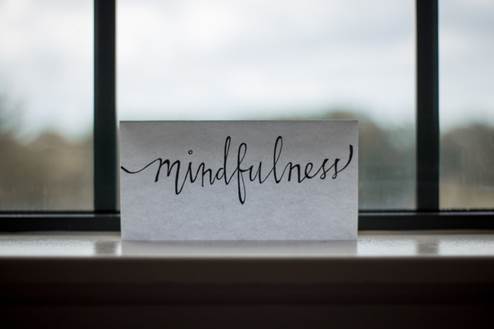
Now let’s take this tool and use it as you head into a New Year… and into any organizing/time management/productivity project large or small about which you feel stuck.
For example, you have a huge amount of memorabilia: inherited from relatives, reminders of your childrens’ youth, and your own school, personal and work papers. This stuff all reminds you with what your life has been woven together. Maybe it even symbolizes your core identity. It’s hard to let to go. Even editing them down, creating digital (photos, scans) records of them does not seem possible.
So let’s STOP PAUSE REFLECT. And ask yourself this: What Matters Most To Me NOW? Is it making room for other activities in the space now clogged with memories of the past? Is it giving myself a beautiful space in which to create my life today? What are my core needs and values, and how might they be best served?
In my experience working with hundreds of clients over the years, they all know these answers, deeply and profoundly. Decluttering and creating a life that reflects who they want to be is greatly facilitated by taking the time and energy to develop the self-awareness that bursts forth from mindfulness. Give it a try!
Wishing you joy during this holiday season,
Geri Chark Frankel
GCF Organizing LLC
Between The Home Edit and Marie Kondo, everyone wants to tidy up. Coupled with sheltering-in and working from home for months, the desire to live with less and deal with our messes has grown.
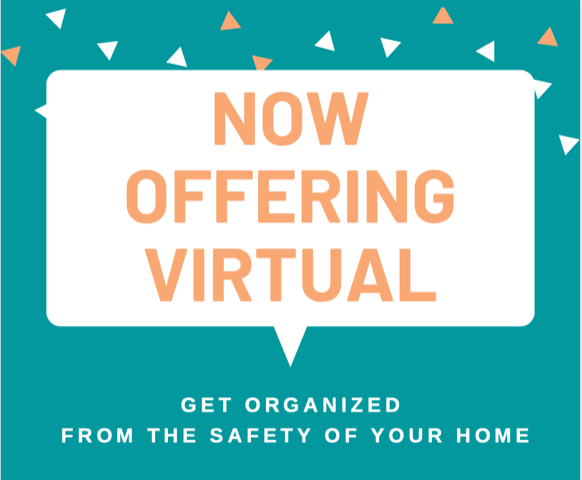
Thanksgiving and the approach of more holidays add incentive to put our homes in order. “Getting organized” has become a need, not a dream.
For those who want the expertise, guidance, and support of a professional organizer, hands on help is still available. If in-person organizing doesn’t work for you, virtual organizing is an option worth considering.
Virtual Organizing is not new…
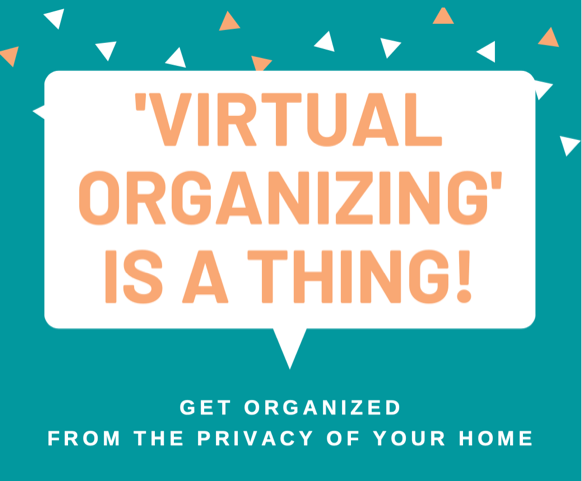
• Over ten years ago, Sheila Delson, co-founder of The Institute for Chronic Disorganization, coined the term Virtual Organizing (V.O.). She has since educated experienced organizers in the best practices and most successful methods for V.O.
In years past, V.O. had been limited by familiarity with zoom and other remote options. With so many adjusting to zoom school, virtual offices and FaceTime meetings, that tech barrier is (virtually) gone making V.O. much more accessible.
Obvious benefits of working virtually:
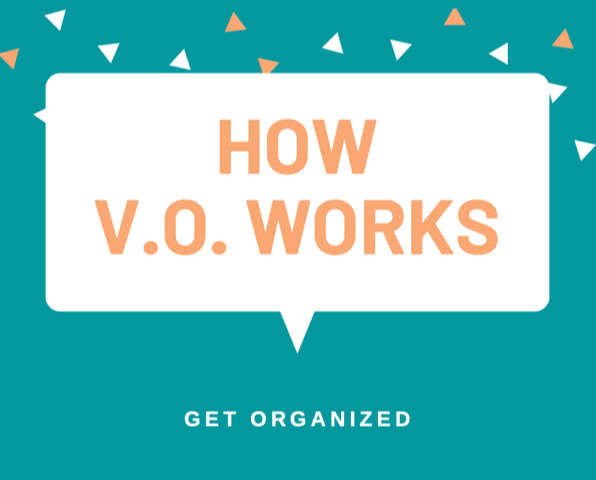
• Guidance on where to start
• Expert clarity for steps involved
• During this pandemic: it is a no-risk option for working together
Five bonus benefits of working remotely:
• Accountability so you’ll follow-through on each step
• Access to resources and connections only your NAPO organizer can provide
• Control over what your organizer sees…or doesn’t 🙂
This may make it easier to focus on a discreet project before you’re ready to open yourself up to a whole room or house re-org.
• Affordability V.O. sessions are typically shorter (1 – 2 hours long) than in-person appointments (which could be half or whole day commitments)
• Any progress you make will be 100% YOURS to claim
If you already have experience working in-person with an organizer, transitioning to a virtual partnership puts the emphasis on what you can do. That’s empowering!
Virtual options aren’t limited to a geographic location.
That said, there are benefits to working with someone local:
• When working with a local organizer, your organizing work can be virtual. Even so, you can still benefit from having your organizer collect items or run some errands, if they handle donations or resale of items.• In the future: post-pandemic, once you’re more comfortable, or when the scope of your project changes, you’d have the option to invite your local organizer in for hands-on organizing. It’s all about choices!
By Adriane Weinberg, An Organized Approach, (215) 540 9401

Let’s admit it. We Americans have Too Much Stuff. And we don’t get rid of nearly enough. Reasons from clients include: it feels impersonal donating things to unknown people or they’re saving stuff for their kids (hey, your kids don’t want it). What if there were a way to give things away that feels good? There is! Buy Nothing groups.
The purpose of Buy Nothing Groups is to give away unwanted items, or request items that are wanted, for free. It’s based on the ancient practice of gift economies where people share and pool resources. The Buy Nothing Project started as a social experiment by two friends, Rebecca Rockefeller and Liesl Clark, in July 2013.
Groups are hyper-local and found on Facebook, which was chosen because it’s a free, widely used platform. The rules are simple. From their website, “Post anything you’d like to give away, lend, or share amongst neighbors. Ask for anything you’d like to receive for free or borrow. Keep it legal. No hate speech. No buying or selling, no trades or bartering, we’re strictly a gift economy.” Easy enough.
These ladies couldn’t have imagined that their little experiment would become a worldwide movement with 1.3 million users in 28 countries and 6,000 volunteers!
For more information or to find a Facebook group in your area, visit https://buynothingproject.org/. Rebecca and Liesl are currently crowdfunding to create a social media platform and app (https://www.soop.app/) to enhance “the power of shared abundance.” Their recently published book, The Buy Nothing, Get Everything Plan: Discover the Joy of Spending Less, Sharing More and Living Generously, shows people how to be a smarter shopper and get rid of things without adding to landfills.
On a related note, Buy Nothing Day is the Friday after Thanksgiving, aka Black Friday. It’s an international day of protest against overconsumption. This year, it’s Friday, November 27, if you’d like to participate.
I’m not anti-stuff. In fact, I have lots of stuff. My house isn’t cluttered, there’s ample space and I can find anything in seconds. For several years, a few years ago, I avoided shopping because I have what I need and much of what I want. I have enough. I don’t buy much anymore, unlike when I was acquiring things in my 20s, 30s and 40s. As a professional organizer, I know it’s about moderation and space. Everyone should do what feels right for their situation.
Many people lost jobs due to COVID-19. Buy Nothing Groups are a great way to save money. Or help neighbors save money by gifting things to them. Maybe you’ll be inspired to check out a Buy Nothing group.